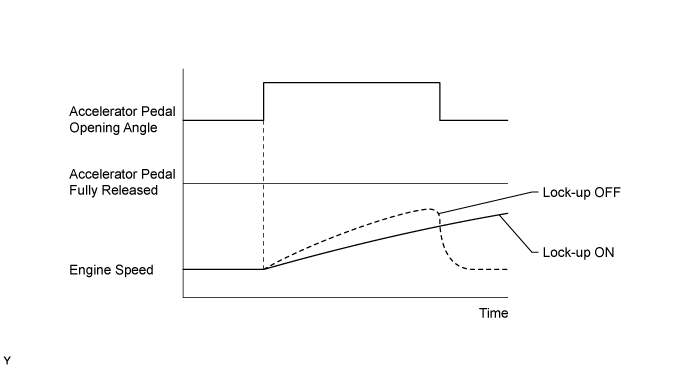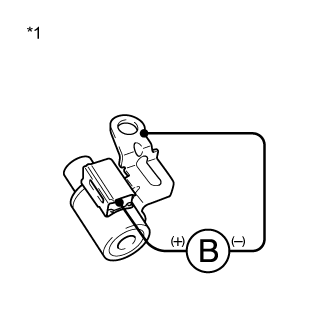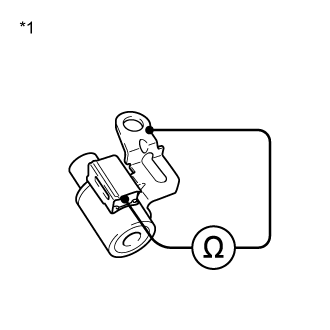DTC P07407F Torque Converter Clutch Actuator Stuck Off |
for Preparation Click here
SYSTEM DESCRIPTION
The ECM uses signals from the throttle position sensor, air-flow meter, input speed sensor NT, output speed sensor NC and crankshaft position sensor to help determine the engagement timing of the lock-up clutch. The ECM monitors the engagement of the clutch using the input speed sensor NT, output speed sensor NC and crankshaft position sensor.Then the ECM compares the engagement condition of the lock-up clutch with the lock-up schedule in the ECM memory to detect mechanical malfunctions of the shift solenoid valve SL, transmission valve body assembly and torque converter assembly.
| DTC No. | DTC Detection Condition | Trouble Area |
| P07407F | 1. Diagnosis Condition 2. Malfunction Status 3. Malfunction Time 4. Other
|
|
MONITOR DESCRIPTION
Torque converter lock-up is controlled by the ECM based on the input speed sensor NT, output speed sensor NC, engine speed, engine load, engine temperature, vehicle speed, transmission fluid temperature, and gear selection signals. The ECM determines the lock-up status of the torque converter by comparing the engine speed (NE) signal to the input speed sensor NT signal. The ECM calculates the actual transmission gear by comparing the input speed sensor NT signal to the output speed sensor NC signal. When conditions are appropriate, the ECM requests "lock-up" by applying control voltage to the shift solenoid valve SL. When the shift solenoid valve SL is turned on, it applies pressure to the lock-up relay valve and locks the torque converter.If the ECM does not detect lock-up after lock-up has been requested or if it detects lock-up when it is not requested, it interprets this as a malfunction of the shift solenoid valve SL or in lock-up system performance, illuminates the MIL and stores this DTC.
- HINT:
- Example:
- If the following conditions are met, the system judges it as a malfunction.
- There is a difference in rotation (speed) between the input side (engine speed) and output side (input turbine speed) of the torque converter when the ECM commands lock-up.
(Engine speed is at least 70 rpm greater than the input turbine speed.)
WIRING DIAGRAM
Refer to DTC P074011 (Click here).INSPECTION PROCEDURE
- NOTICE:
- Perform registration and/or initialization when parts related to the automatic transaxle are replaced (Click here).
- HINT:
- Using the GTS to perform Active Tests allows relays, VSVs, actuators and other items to be operated without removing any parts. This non-intrusive functional inspection can be very useful because intermittent operation may be discovered before parts or wiring is disturbed. Performing Active Tests early in troubleshooting is one way to save diagnostic time. Data List information can be displayed while performing Active Tests.
- After performing repair, clear the DTCs and perform the following procedure to check that DTCs are not output.
- Perform the Lock-up Function inspection in Road Test (Click here).
- Turn the engine switch off.
- Perform step (a) again.
- Check for DTCs again (Click here).
| ACTIVE TEST |
Warm up the engine.
Turn the engine switch off.
Connect the GTS to the DLC3.
Turn the engine switch on (IG).
Turn the GTS on.
Enter the following menus: Powertrain / Transmission / Active Test / Activate the Lock Up Solenoid.
Perform the Active Test according to the display on the GTS.
Transmission Tester Display Test Part Control Range Diagnostic Note Activate the Lock Up Solenoid Controls the shift solenoid valves SLU and SL to control the automatic transaxle lock-up condition ON/OFF Can be used to check the operation of the shift solenoid valves SLU and SL.
[Vehicle Condition]- Throttle valve opening angle: Less than 20%
- Vehicle speed: 60 km/h (37 mph) or more in 6th gear
- HINT:
- This Active Test can be performed when the vehicle speed is 60 km/h (37 mph) or more.
- Throttle valve opening angle: Less than 20%
Lightly depress the accelerator pedal and check that the engine speed does not change abruptly.

- HINT:
- When changing the accelerator pedal opening angle while driving, if the engine speed does not change, lock-up is on.
- Slowly release, but not fully, the accelerator pedal in order to decelerate. (Fully releasing the pedal will close the throttle valve and lock-up may be turned off.)
| 1.CHECK OTHER DTCS OUTPUT (IN ADDITION TO DTC P07407F) |
Connect the GTS to the DLC3.
Turn the engine switch on (IG).
Turn the GTS on.
Enter the following menus: Powertrain / Transmission / Trouble Codes.
Read the DTCs using the GTS.
- Result:
Result Proceed to Only DTC P07407F is output A DTC P07407F and other DTCs are output B
- HINT:
- If any DTCs other than DTC P07407F are output, perform the troubleshooting for those DTCs first.
|
| ||||
| A | |
| 2.CHECK TRANSMISSION WIRE |
Remove the wiring harness connector.
Text in Illustration *a Component without harness connected
(Transmission Wire)
 |
Measure the resistance according to the value(s) in the table below.
- Standard Resistance:
Tester Connection Condition Specified Condition A-6 (SL) - Body ground 20°C (68°F) 11 to 15 Ω
|
| ||||
| OK | |
| 3.INSPECT SHIFT SOLENOID VALVE SL (OPERATION) |
Remove shift solenoid valve SL.
Text in Illustration *1 Shift Solenoid Valve SL
 |
Connect a positive (+) lead from the battery to the terminal of the solenoid valve connector and a negative (-) lead to the solenoid body. Check that the valve moves and makes an operating sound.
- OK:
- Valve moves and makes an operating sound.
|
| ||||
| OK | |
| 4.INSPECT TRANSMISSION VALVE BODY ASSEMBLY |
Check the transmission valve body assembly (Click here).
- OK:
- There is no foreign matter on each valve and they operate smoothly.
|
| ||||
| OK | |
| 5.INSPECT TORQUE CONVERTER ASSEMBLY |
Check the torque converter assembly (Click here).
- OK:
- The torque converter assembly is normal.
|
| ||||
| OK | ||
| ||
| 6.INSPECT SHIFT SOLENOID VALVE SL (RESISTANCE) |
Remove the shift solenoid valve SL.
Text in Illustration *1 Shift Solenoid Valve SL
 |
Measure the resistance according to the value(s) in the table below.
- Standard Resistance:
Tester Connection Condition Specified Condition Solenoid Connector (SL) - Solenoid Body (SL) 20°C (68°F) 11 to 15 Ω
|
| ||||
| OK | ||
| ||
